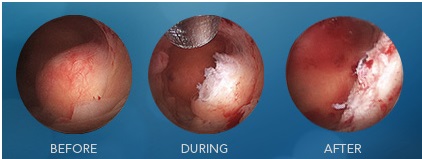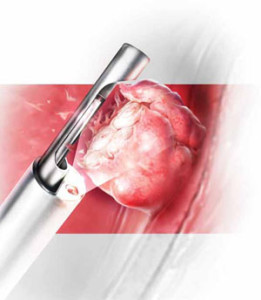Hysteroscopic Myomectomy (MyoSure)
Hysteroscopy Fibroid Resection (Myomectomy)
What is hysteroscopy Fibroid resection?
It is a procedure of removing fibroids that occur on the inside of the womb (uterus) via the vagina using an instrument called hysteroscope
Why is it done?
Fibroids are benign ball-like swellings in the wall of your uterus. They are created from an overgrowth of muscle fibres. You may have one or more fibroids. Most fibroids do not cause problems and do not require treatment, but can sometimes be troublesome.
These can cause a number of symptoms including:
- Pain
- Heavy periods (menorrhagia)
- Pressure on your bladder, bowel or back spine.
- Fibroids can cause miscarriages and problems when trying to become pregnant.

What to expect after surgery?
If your reason for the operation is heavy periods or irregular menstrual bleeding, then your periods will be likely lighter and more regular afterwards. You will see improvements over the next 2-3 months. If you received Endometrial Ablation at the same time of your hysteroscopic resection, reduction in bleeding will be even more pronounced.
If your fibroids had made conceiving difficult then your chance of getting pregnant may improve after hysteroscopic resection. Please remember that the ability to conceive depends on many factors and therefore it is difficult to predict who will be successful after resection of fibroid
You may have some cramping abdominal pains and pain relief is given for this. Some vaginal blood loss may occur but not too much to cause concern.
What are the risks of the surgery?
- You may get adverse reaction with anaesthetics.
- Excessive bleeding during the operation: If bleeding is not controlled by diathermy coagulation, it may be necessary to use pressure from an inflated catheter that is inserted into the womb.
- Infection of the womb: Small risk and usually presented as offensive vaginal discharge. This is treatable with antibiotics.
- Organ perforation: Risk of puncture of the uterus occurs in 1-2 per 1000 operations. Sometimes, when this happens, there is a small risk of bowel injury at the same time.
- Excessive fluid absorption
What are the alternatives to the surgery?
- Drug treatment – You can take drugs to shrink the fibroids, but this is unlikely to be permanent and the fibroids may grow back.
- Keyhole surgery – We can sometimes remove smaller fibroids using keyhole instruments passed through tiny cuts in your abdomen. This is more commonly used for serosal or intra-mural fibroids.
- Embolisation – This is a method of shrinking single fibroids by cutting off their blood supply.
- Hysterectomy – This is an operation to remove your uterus. If you never want to become pregnant and do not mind losing your uterus then this will stop your bleeding problems permanently.

What is the MyoSure Hysteroscopic Myomectomy Procedure?
The inside of the uterus is very important since this is where a pregnancy will implant and grow. Problems of the tissue lining and the muscle of the uterus lead to abnormal uterine bleeding or infertility. MyoSureTM is a simple procedure that eliminates your fibroids without having to remove or even cut the uterus. A morcelator instrument is inserted into the uterus through the vagina to take out the fibroid. Once the fibroid has been removed, your period should go back to normal. The MyoSure procedure is the ideal treatment option if you are looking to reduce your heavy bleeding caused by polyps or fibroids, while retaining a fully functional uterus.
Dr Angstetra provides surgical expertise to ensure that any problem you have within the uterus is dealt with carefully by using the latest technology to maintain excellent gynaecological health and fertility.
